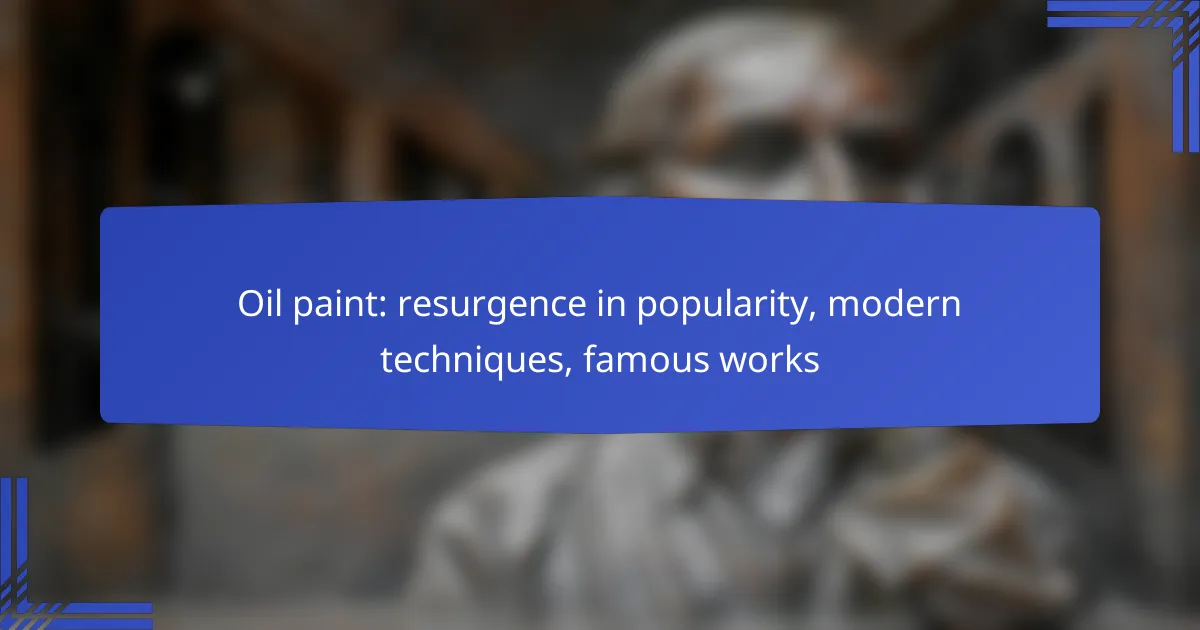Oil paint is experiencing a resurgence in popularity, driven by a renewed appreciation for traditional techniques and the vibrant possibilities it offers. Modern artists are embracing innovative methods such as layering and mixed media to create unique textures and expressions, while also addressing contemporary themes in their work. This blend of tradition and innovation is making oil painting a favored medium in today’s art scene.
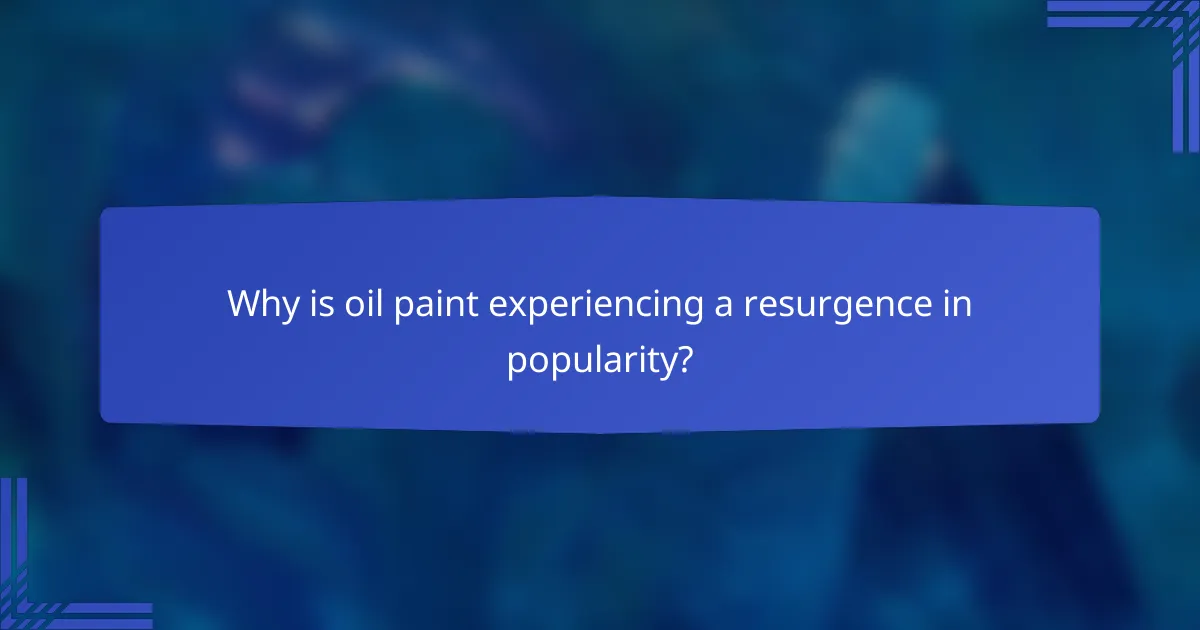
Why is oil paint experiencing a resurgence in popularity?
Oil paint is regaining popularity due to a growing appreciation for traditional art techniques, the influence of social media, and the therapeutic benefits of painting. Artists and hobbyists alike are drawn to the rich textures and vibrant colors that oil paints offer, making them a favored medium in contemporary art.
Increased interest in traditional art techniques
Many artists are returning to oil paint as they seek to master traditional techniques that have been used for centuries. This revival is often driven by a desire for authenticity and craftsmanship in an age dominated by digital art. Workshops and classes focusing on oil painting techniques are becoming more common, providing opportunities for hands-on learning.
Additionally, the tactile nature of oil paint allows for a unique creative expression that many find lacking in other mediums. Artists appreciate the slow drying time, which enables blending and layering that can create depth and complexity in their work.
Influence of social media platforms
Social media platforms like Instagram and TikTok have played a significant role in the resurgence of oil painting. Artists can showcase their work to a global audience, gaining inspiration and feedback from fellow creators and art enthusiasts. This visibility encourages more people to experiment with oil paints, as they see the diverse ways in which the medium can be used.
Hashtags related to oil painting often trend, leading to communities where artists share techniques, tips, and finished pieces. This online engagement fosters a sense of belonging and motivates individuals to pursue oil painting as a serious hobby or career.
Rise of art therapy practices
The increasing recognition of art therapy has contributed to the popularity of oil painting. Many therapists incorporate oil painting into their practices, as it allows individuals to express emotions and relieve stress through creative outlets. The sensory experience of working with oil paints can be particularly soothing and fulfilling.
Art therapy sessions often focus on the process rather than the final product, encouraging participants to explore their feelings and thoughts. This therapeutic approach has made oil painting accessible to a broader audience, including those who may not consider themselves traditional artists.
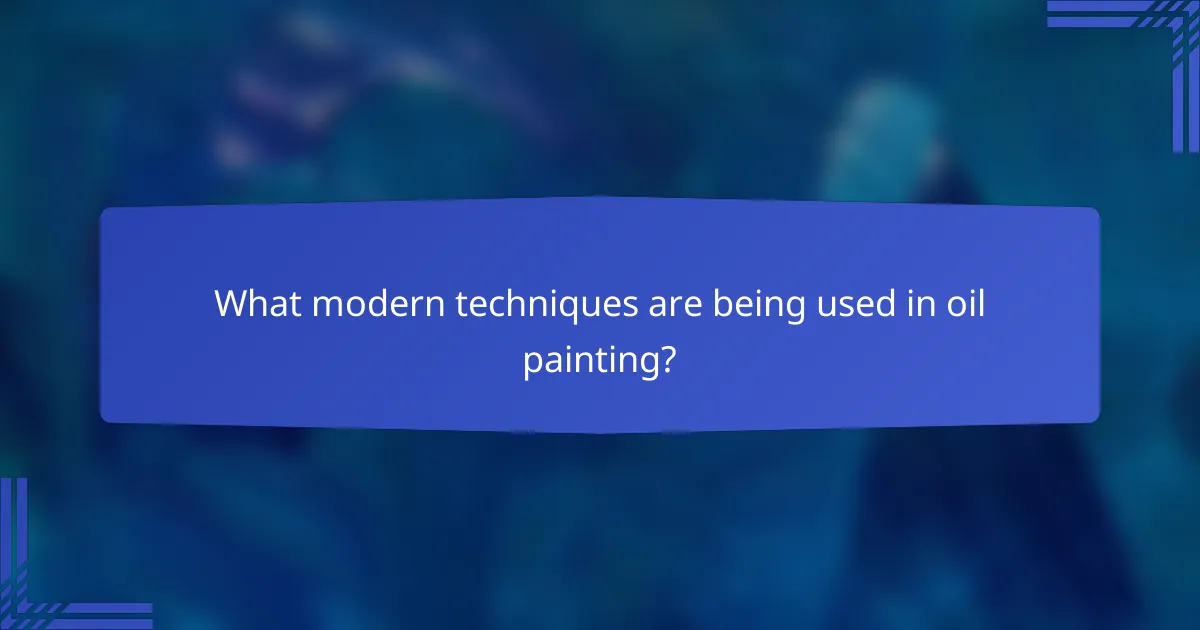
What modern techniques are being used in oil painting?
Modern oil painting techniques enhance traditional methods, allowing for greater creativity and expression. Artists today utilize various approaches, including layering, impasto, and mixed media, to achieve unique effects and textures.
Layering and glazing methods
Layering and glazing involve applying multiple thin layers of oil paint, allowing each layer to dry before adding the next. This technique creates depth and luminosity, as light interacts with the layers. Artists often use transparent colors for glazing to build richness without overwhelming the underlying layers.
When using this method, it’s crucial to allow adequate drying time between layers, which can range from a few days to weeks, depending on the thickness and type of paint. A common pitfall is applying too much paint too quickly, which can lead to cracking.
Impasto technique for texture
The impasto technique involves applying thick layers of paint to create a three-dimensional texture on the canvas. This method allows for dramatic brush strokes and a tactile quality that can enhance the visual impact of the artwork. Artists often use palette knives or stiff brushes to apply the paint in a way that stands out from the surface.
To achieve effective impasto, consider using a medium that increases the paint’s viscosity, such as a gel or paste. Be mindful of the drying time, as thicker applications may take longer to dry, which can affect subsequent layers or varnishing.
Mixed media approaches
Mixed media in oil painting involves combining oil paints with other materials, such as acrylics, pastels, or collage elements. This technique allows artists to explore new textures and effects, broadening their creative possibilities. For instance, incorporating paper or fabric can add depth and interest to a piece.
When working with mixed media, it’s essential to consider the compatibility of materials. Some mediums may react negatively with oil paints, leading to issues like peeling or discoloration. Always test materials on a small scale before applying them to the final artwork to ensure a successful outcome.
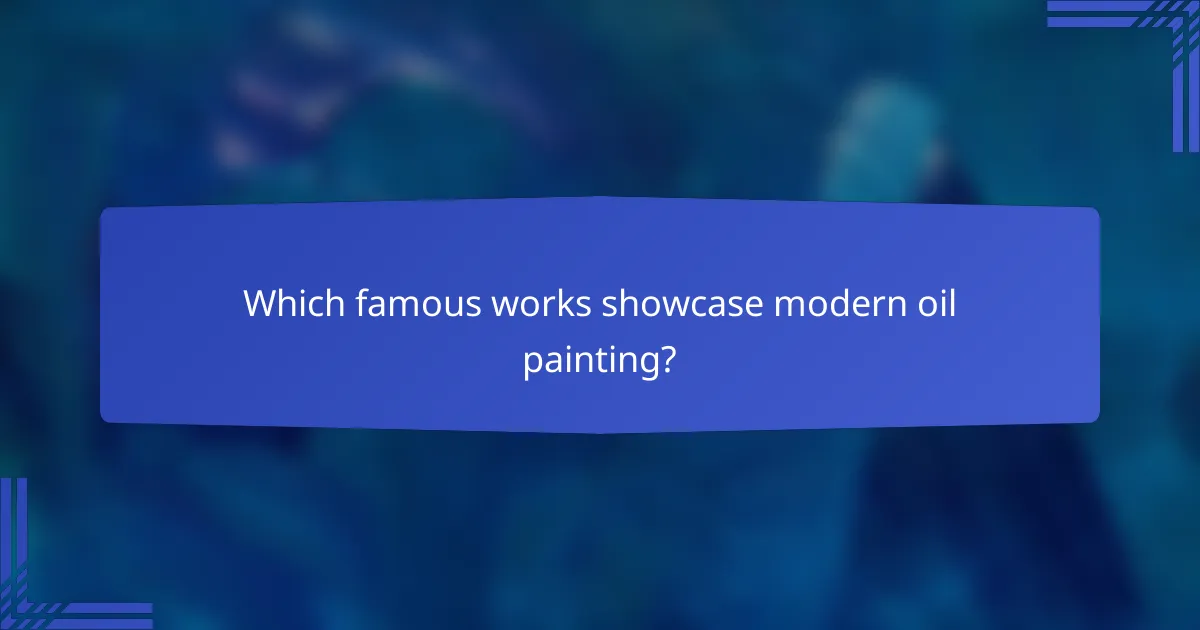
Which famous works showcase modern oil painting?
Modern oil painting is highlighted by a variety of renowned works that reflect contemporary themes and techniques. Artists today are pushing boundaries, creating pieces that resonate with current societal issues while utilizing traditional oil painting methods.
Works by contemporary artists like Kehinde Wiley
Kehinde Wiley is celebrated for his vibrant portraits that challenge traditional representations in art. His work often features people of color in poses reminiscent of classical European portraiture, merging modern identity with historical context. Notable pieces include “Portrait of a Young Gentleman,” which showcases Wiley’s signature style and bold use of color.
Wiley’s approach to oil painting involves intricate patterns and textures, drawing attention to the subjects while maintaining a connection to art history. His works are often displayed in prominent galleries, further solidifying the relevance of modern oil painting.
Notable pieces from the New York School
The New York School, a group of mid-20th century artists, produced influential works that redefined oil painting. Artists like Jackson Pollock and Mark Rothko explored abstraction, using oil paint to express emotion and spontaneity. Pollock’s “No. 5, 1948” exemplifies his drip technique, creating dynamic compositions that engage viewers on multiple levels.
Rothko’s color field paintings, such as “Orange and Yellow,” utilize large blocks of color to evoke feelings and provoke thought. These pieces demonstrate how modern oil painting can transcend traditional forms, focusing on the emotional impact rather than representational accuracy.
Influential exhibitions in major cities
Exhibitions in cities like New York, London, and Paris have played a crucial role in showcasing modern oil painting. Events such as the Whitney Biennial and the Venice Biennale highlight contemporary artists and their innovative approaches to oil paint. These exhibitions often feature a mix of established and emerging artists, providing a platform for diverse voices in the art world.
Visiting these exhibitions allows art enthusiasts to experience firsthand the evolution of oil painting techniques and themes. Attendees can engage with artists and curators, gaining insights into the creative process and the significance of modern works in today’s cultural landscape.
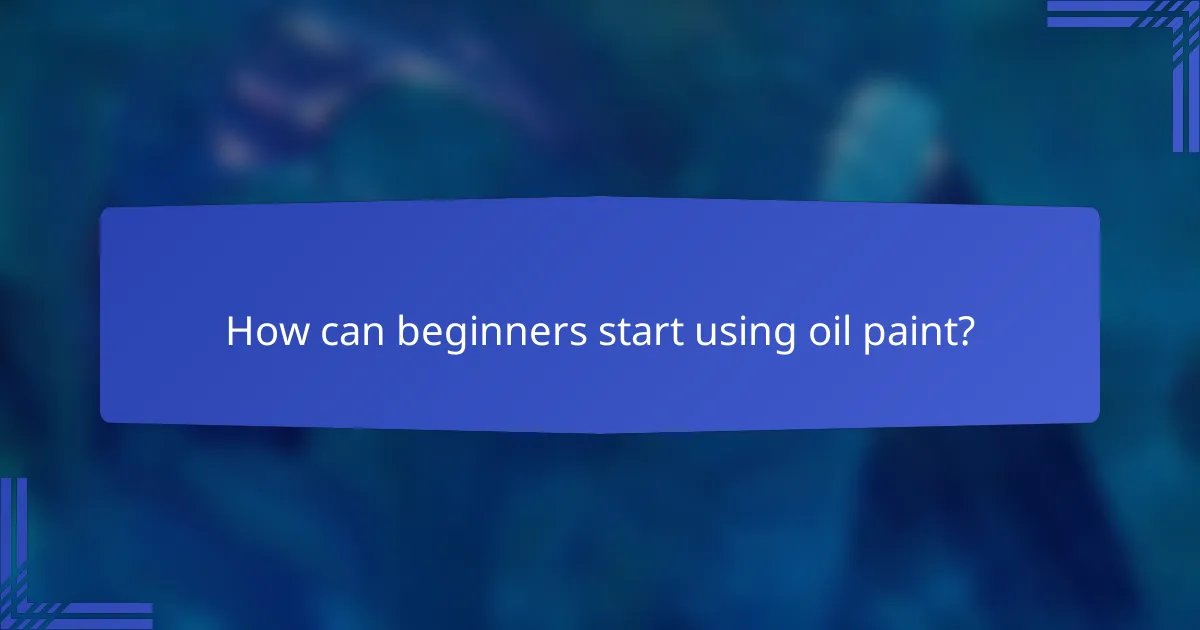
How can beginners start using oil paint?
Beginners can start using oil paint by gathering essential materials, learning basic techniques, and exploring online resources. This approach helps to build a solid foundation for creating art with oil paints.
Essential materials for beginners
To begin oil painting, you will need a few key materials. Essential items include oil paints, brushes designed for oil, a palette for mixing colors, and a canvas or canvas board. Additionally, consider having a palette knife, linseed oil or another medium, and turpentine or odorless mineral spirits for cleaning brushes.
When selecting oil paints, opt for a basic set of primary colors along with white and black. This allows for a wide range of mixing options without overwhelming choices. Brands like Winsor & Newton and Gamblin offer quality paints suitable for beginners.
Basic techniques to learn first
Start with foundational techniques such as glazing, scumbling, and wet-on-wet painting. Glazing involves applying thin, transparent layers of paint to create depth, while scumbling uses a dry brush to add texture and light. Wet-on-wet allows for blending colors directly on the canvas, which is great for creating soft transitions.
Practice these techniques on small canvases to build confidence. Focus on color mixing and brush control, as these skills are crucial for successful oil painting. Avoid overworking the paint, as this can muddy colors and lead to unsatisfactory results.
Recommended online courses and tutorials
Many online platforms offer courses tailored to beginners in oil painting. Websites like Skillshare and Udemy feature classes that cover basic techniques, color theory, and composition. Look for courses with high ratings and positive reviews to ensure quality instruction.
YouTube is another valuable resource, with numerous tutorials available for free. Channels dedicated to painting often provide step-by-step guides and tips for beginners. Consider following artists who share their processes and techniques to gain insights into oil painting.
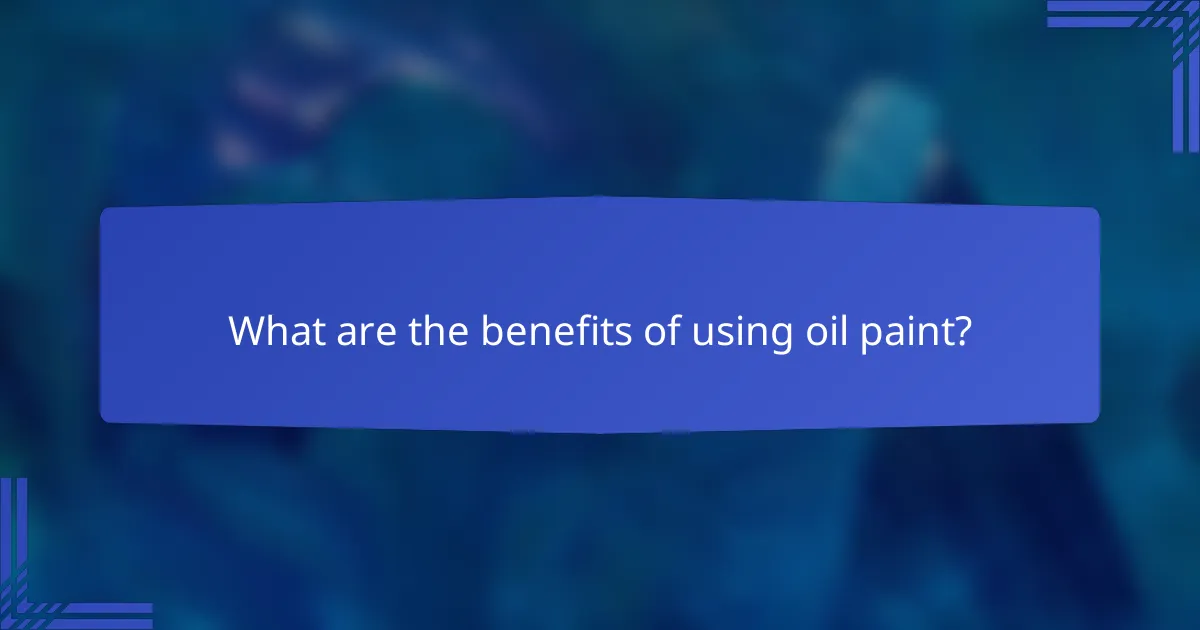
What are the benefits of using oil paint?
Oil paint offers several advantages, including vibrant color saturation, a long drying time that allows for blending, and exceptional durability of finished works. These benefits make it a preferred medium for many artists, both traditional and contemporary.
Rich color saturation
One of the standout features of oil paint is its rich color saturation. The oil base allows pigments to maintain their vibrancy, resulting in deep, intense colors that can be layered for added depth. Artists often find that oil paints can produce a wider range of hues compared to other mediums.
To achieve optimal saturation, consider using high-quality pigments and mixing them with a suitable medium. This ensures that the colors remain true and vibrant over time, enhancing the overall visual impact of the artwork.
Long drying time for blending
The long drying time of oil paint, which can range from several days to weeks, provides artists with the ability to blend colors seamlessly. This characteristic is particularly beneficial for techniques like glazing and scumbling, where gradual color transitions are desired.
While the extended drying period allows for more detailed work, it can also pose challenges. Artists should plan their sessions accordingly and consider using mediums that can speed up or slow down drying times based on their specific needs.
Durability of finished works
Oil paintings are known for their durability, often lasting for centuries without significant deterioration. The oil forms a strong, flexible film that protects the pigments from fading and environmental damage. This longevity makes oil paint an excellent choice for artists aiming to create lasting pieces.
To ensure the durability of oil paintings, it is essential to use proper varnishes and store artworks in stable environments. Avoiding direct sunlight and extreme temperatures can help maintain the integrity of the colors and the overall piece over time.

What challenges do artists face with oil paint?
Artists encounter several challenges with oil paint, primarily due to its unique properties and the materials used in the painting process. Key issues include long drying times and health concerns related to solvents, both of which can impact workflow and safety.
Long drying times
One of the most significant challenges with oil paint is its long drying time, which can range from several days to weeks depending on the thickness of the application and environmental conditions. This slow drying process allows for blending and layering but can hinder an artist’s ability to work quickly or make immediate changes.
To manage drying times, artists often use mediums that can accelerate the drying process, such as alkyds or certain drying oils. However, it’s essential to balance speed with the desired finish, as faster drying can affect the paint’s texture and color vibrancy.
Health concerns with solvents
Health concerns arise from the use of solvents commonly associated with oil painting, such as turpentine and mineral spirits. These substances can emit harmful fumes and pose risks of skin irritation, respiratory issues, and long-term health effects if not handled properly.
Artists should consider using odorless solvents or alternatives like citrus-based solvents to minimize health risks. Proper ventilation in the workspace is crucial, along with using personal protective equipment like gloves and masks to ensure safety while working with oil paints and their solvents.
